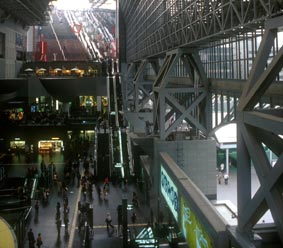| Kyoto Station |
 |
 |
|
The Three Stages in the History of the Preservation of Cultural Heritage in Japan.
Arriving nowadays in Kyoto by train one hardly has a sensation
of having arrived at the famous hana no miyako, the Capital of Flowers of old, but rather of having emerged into the center of Manhattan or any other Megalopolis. The new Kyoto Station Building, designed by Hiroshi Hara and opened in October 1997, has no equal on this planet in terms of size or unique spatial gran-deur. Being magically lured up to the top of the sixty meter high interior atrium on various linked huge escalators, one is presented a breathtaking view down to hustle and bustle of travellors on the ground. Ironically, from the top platform of this most recent Mega-Building one is granted a view over the most important remainder and asset of the original ancient city; like from nowhere else one can witness that Kyoto was and still is uniquely placed into a horseshoe of untouched mountains. In this sense, even in the most recent modern addition of Kyoto’s townscape, one is aware that in Kyoto origin is always present.
|
